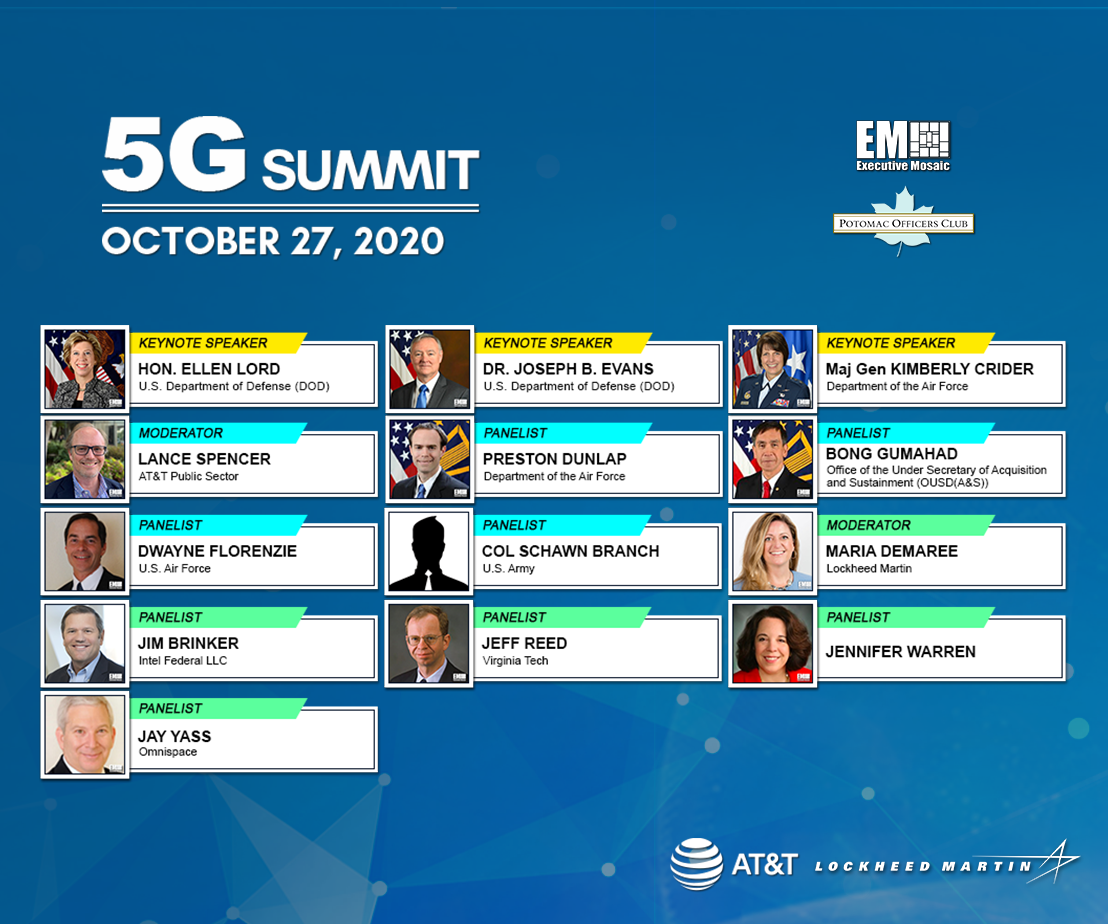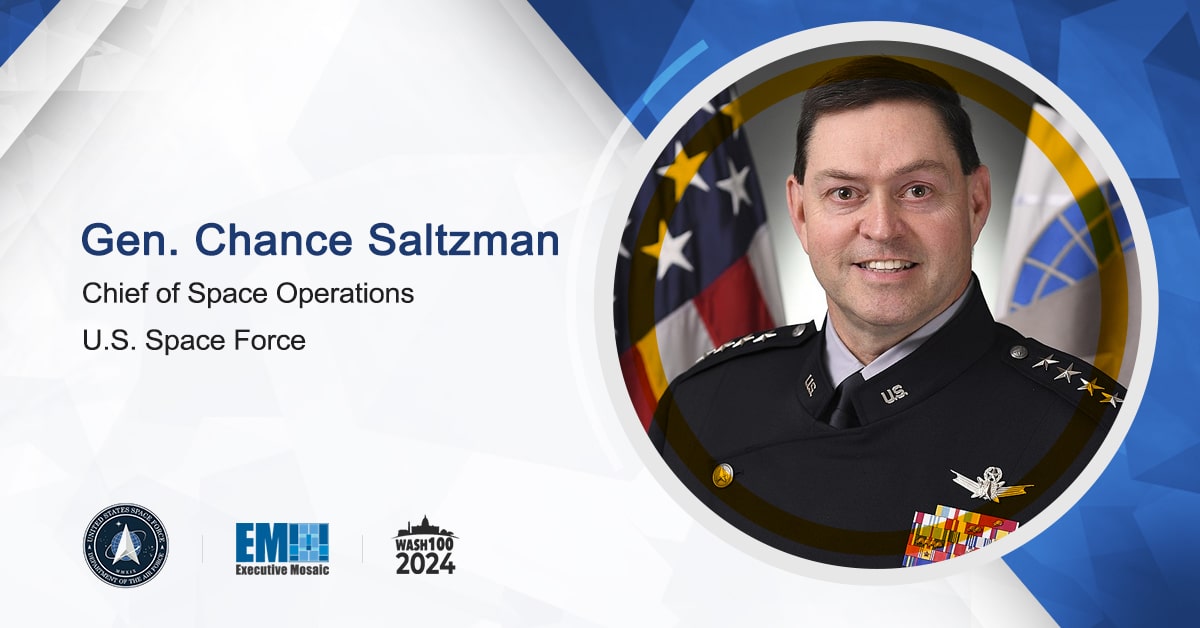In March 2020, the White House released its National Strategy to Secure 5G of the United States to frame how the nation will safeguard 5G wireless infrastructure at home and across the globe. The new law directs the president to produce a strategy “to ensure security of next generation wireless communications systems and infrastructure,” within 180 days of its enactment.
5G wireless technology is anticipated to unleash unprecedented levels of connectivity between millions of new internet of things devices and there are already a range of deployments making their way across the U.S. and in a few federal agencies.
During Potomac Officers Club’s 5G Summit, Ellen Lord, undersecretary for acquisition and sustainment at the Department of Defense (DoD) and four-time Wash100 Award recipient, will be featured as the keynote speaker.
Lord will discuss the impact that innovative technologies and 5G integration have on the private and public sectors, the steps the federal agencies have taken to remain up to speed with the rapid advancement of technology, and the future programs, plans and priorities as the nation aligns with emerging technology.
To Register for the 5G Summit, and view other upcoming events, visit Potomac Officers Club’s Event Page!
Dr. Joe Evans on 5G RFPs
Dr. Joe Evans, technical director for 5G, reporting directly to the under secretary of Defense for Research and Engineering within the Office of the Secretary of Defense, recently analyzed the second wave of the defense department’s 5G RFPs. Evans will serve as a keynote speaker during Potomac Officers Club’s 5G Summit.
The DoD has recently announced its plans to issue additional requests for proposals (RFPs) in the coming weeks for 5G wireless prototypes at a second tranche of U.S. military bases. New RFPs will be issued through the National Spectrum Consortium and Information Warfare Research Program.
“DoD recognized that industry is driving 5G technology with massive investments,” said Evans. “The projection on capital expenditure in the U.S. through 2025 is about $350 billion.”
Joint Base San Antonio and other remote sites have formed a 5G core security experimentation network for evaluating the security and interoperability of 5G backbone networks. The tests could help additional U.S. companies enter the 5G market, Evans added.
Ellen Lord on Microelectronics Supply Chain
Lord recently stated that the U.S. needs to leverage domestic resources in microelectronics production for current and future defense needs. She told attendees at a Defense Advanced Research Projects Agency (DARPA) summit that reliance on overseas manufacturers for microelectronics could pose risks to national security.
She noted that public-private partnerships can help encourage U.S. suppliers to produce microelectronic components. “Then we partner with other industrial sectors to sustain that,” said Lord. “And we have a pretty strong demand signal in order to be able to do that.”
According to Lord, her office is working with colleagues within and outside the DoD to drive domestic microelectronics manufacturing and ensure the security of the U.S. supply chain.
“DoD not only drives research and development, but we also work on developing the workforce of the future we need,” Lord added. “If you take a holistic approach, I think we can create a sustainable microelectronics industry, but it’s not just about that first plant with some equipment in it. It’s about the workforce.”
Lord will serve as a keynote speaker during Potomac Officers Club’s 5G Summit.
Maj. Gen. Kimberly Crider Discusses Digital Service
Maj. Gen. Kimberly Crider, acting chief technology and innovation officer (CTIO) of the Space Force and keynote speaker during Potomac Officers Club’s 5G Summit, recently discussed the initiatives of the U.S. Space Force, stating that the agency will be a “digital service” on the leading edge of technology, SpaceNews reported on Friday.
“Our goal is to be the first digital service by design, to be born digital as we stand up at this new service,” says Crider. “We want to utilize digital technologies and digital capabilities in all the things that we do and we want to develop a digital workforce.”
The Space Force, created the Chief Technology Innovation Office (CTIO), will ensure that technology and innovation are primary focal points of the agency to attract quality talent. The agency will use digital engineering to develop its future Space Force’s tech-heavy vision to overcome obstacles.
5G and Cybersecurity Strategy
The Cybersecurity and Infrastructure Security Agency (CISA) has issued a new strategy to ensure the resilience and security of the country’s 5G infrastructure. CISA’s 5G Strategy has five strategic initiatives that support the four lines of effort of the National Strategy to Secure 5G.
These initiatives are supporting 5G policy and standards development by emphasizing security and resiliency; expanding situational awareness of 5G supply chain risks and promoting security measures; partnering with stakeholders to secure and strengthen existing infrastructure to support future 5G deployments; encouraging innovation in the 5G marketplace to promote trusted 5G vendors; and analyzing potential 5G use cases and sharing information on risk management strategies.
“The promise of 5G is undeniable, but with 5G technology posed to underpin a wide range of critical infrastructure functions, it’s vital that we manage these risks adequately and promote a trusted ecosystem of 5G componentry,” said CISA Director and a 2020 Wash100 Award winner Christopher Krebs. “CISA is committed to working with partners to build a resilient 5G infrastructure, and this strategy identifies a roadmap of how we will bring stakeholders together to achieve this.”
Each initiative seeks to address physical security concerns, supply chain vulnerabilities and other critical risks to secure 5G deployment. The document also outlines specific responsibilities and measures within each strategic initiative to ensure a resilient and secure 5G infrastructure.
5G-Enabled Military Warehousing Platforms
The National Spectrum Consortium has posted a final request for prototype proposals to inform its members of the opportunity to develop and test 5G-enabled technology prototypes in U.S. Marine Corps (USMC) warehouse operations.
The RPP released March 11 seeks industry participants to demonstrate the potential of 5G connectivity and augmented and virtual reality approaches to help the service branch manage assets and functions at USMC Logistics Base Albany in Georgia.
In a prior solicitation, DoD unveiled plans to conduct 5G testbed experiments at the USMC installation that provides facilities, infrastructure and support services to military tenants. The department also identified Hill Air Force Base in Utah as the second location for full-scale 5G mobile spectrum sharing experiments.
Another RPP identified Joint Base Lewis-McChord in Washington as the location for 5G-based AR/VR training efforts, while the Naval Supply Systems Command Fleet Logistics Center in California will host asset management experiments based on a 5G network.
The Pentagon noted that NSC is the only consortium that “encompasses the expertise, knowledge, technologies, and innovation” for conducting R&D activities seeking to leverage the electromagnetic spectrum.
Join Potomac Officers Club’s 5G Summit to hear notable federal and industry leaders further discuss emerging programs, priorities and challenges within the integration process of the new 5G framework. As emerging technologies continue to become an integral part of business and innovation, leaders across all divisions must stay ahead of the curve to tackle national and global issues.
To Register for the 5G Summit, and view other upcoming events, visit Potomac Officers Club’s Event Page!






